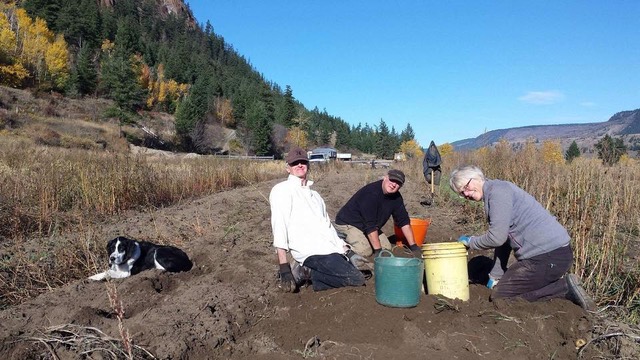By Nola Daintith and Rodger Hamilton –
For the last three years, two very generous market gardeners near Soda Creek, north of Williams Lake, have opened their potato patches and other vegetable fields in the fall to the Cariboo-Chilcotin Conservation Society (CCCS). Members of the CCCS along with friends, students, and assorted dogs have spent an enjoyable day or two gleaning potatoes, carrots, squash, and other veggies, but mostly potatoes—and a lot of potatoes! The idea behind the gleaning project was to collect the last of the crops (that were likely too expensive to harvest and market) and store them into the winter for community organizations to distribute to clients who might not otherwise have access to healthy, homegrown food. And, what better place to store them than in the renovated cold-storage area in the basement of the Potato House in Williams Lake.

This year the potato project will be a little more hands-on for the CCCS. Thanks to Puddle Produce Farm in Soda Creek, the CCCS will have its own potato field to prepare, plant, tend, and harvest. So, while the CCCS is busy in its potato patch, why not consider joining the volunteers in planning or creating your own backyard patch? According to a favourite gardening source, West Coast Seeds (westcoastseeds.com), potatoes are important to the self-sufficient gardener, easy to grow, and highly nutritious, and there is a variety for every use in the kitchen. They recommend the heirloom variety Sieglinde or German butter potato.
If you are lucky, you may be able to find some “Cariboo” variety seed potatoes, but not commercially. According to an article in The Tyee, titled “The Potato Underground,” the Cariboo was a popular variety in the 1960s and 70s, but it was decertified for seed production in 1976 because the vines tangled up in commercial potato harvesters. You may be able to beg a few off someone who has been growing them locally and, according to some, they are well worth trying to find—a beautiful white potato with pink eyes, good size, and excellent for keeping. The Cariboo region has a rich farming history that stretches back to the gold rush and it gained a reputation for producing quality potatoes. In the years after World War Two, there were 35 seed potato growers between McLeese Lake and Hixon. The Cariboo potato was bred at the federal Potato Research Centre in New Brunswick, but it got its name because it did unusually well in the tough climate of central BC.
Raising enough potatoes to last the winter takes a lot of garden space, and potatoes are readily available all year long. But, growing new potatoes is a whole different and delicious story, and they are easily grown in small gardens or containers. New potatoes are just a potato that is harvested early, approximately seven or eight weeks after planting, when the tubers are small and very tender with thin skins. For new potatoes look for a variety that is described as having a “waxy texture” such as Russian banana fingerlings, a variety that has been grown in BC for over 90 years. New potatoes aren’t meant for storage, but who can resist eating those gems right away? Growing up on the prairies with a big prairie garden we grew enough potatoes to last well into winter, but we always sacrificed a few hills for a family favourite of boiled new potatoes with butter, fresh chives, and dill.
Potatoes like a rich, slightly acid soil and a good supply of water. We have a small backyard garden and potatoes that we have grown have been scabby, but edible. Scab is most severe in warm, dry, alkaline soils, which are very common in this area. This spring, I think we will follow the advice in The Vegetable Gardener’s Container Bible and try our luck at growing some new potatoes in large containers where we can control soil pH and moisture. To get our full potato fix, we will also be regulars at the Farmer’s Market where we know we can buy really nice potatoes from dedicated and hard-working local farmers.
For more than 20 years, the Cariboo Chilcotin Conservation Society has been working with the community to maintain and enhance the health of the environment as the basis of a strong economy and vital society. For more info about their programs contact www.ccconserv.org. Nola and Rodger are gardeners in Williams Lake whose backyard vegetable garden is spilling over into the front yard.

